#asuci
Explore tagged Tumblr posts
Text
Justin Nguyen (he/him/his) UCI '24

Major/Minor: Human Biology and Public Health
Career Goals: NP or PA
Introduction: Hi! My name is Justin Nguyen, and I just graduated from UCI. I am currently in my gap year trying to figure out what career path I resonate with more but I am learning more towards going the nursing route. I plan to take an extra gap year after this year to take time for myself, and actually take a break. I currently work full time as a medical scribe at a cardiologist office for both a doctor and a PA. It's been such a great learning experience to see both sides of the medical profession, and would definitely recommend scribing as it is very undermine. I also work part-time at a poke restaurant! In my free time (which is limited), I like to spend time with friends as a way of destressing. I love to try new food, new cafes, and honestly go on spontaneous adventures. Fun Fact: I am a boba fiend 😈. I've lost track of my boba count this year, but in the past years, I've had 200. I also like to take pictures and watch anime when I have time.
Involvements: ASUCI; Sage Scholar; UCGHI Student Ambassador; Medical Scribe
Extracurriculars: Photography; Working at a poke restaurant
What kind of advice would you give?: career; social
Best piece of advice you have received: "Feedback is a gift, not a judgment."
Preferred method(s) of communication: phone number, facebook messenger, instagram
0 notes
Photo

When you just really connect with the lyrics. Summerlands was pretty hype not gonna lie. First time listening to @p_lo and @ellamai and I was really feelin it, especially with amazing friends. Yay to new music experiences! @madeon though, was perfect for me. Played a lot of his old stuff and a good amount of new stuff and I was def feelin that! 📸: @meagandelrose #summerlands #uci #ucirvine #irvine #music #festival #asuci #plo #ellamai #madeon #bayarea #simp #edm #shelter #virtualself #island #thecity #fun #adventure #friends (at University of California, Irvine)
#uci#asuci#shelter#summerlands#plo#irvine#fun#island#ucirvine#festival#music#ellamai#friends#adventure#simp#bayarea#thecity#edm#madeon#virtualself
1 note
·
View note
Text
#IAmUCI: Rafael Carrazco-Sanchez
Rafael Carrazco-Sanchez is a senior majoring in criminology, law & society and is the current ASUCI vice president. He is one of the student organizers behind Hunger & Homelessness Awareness Week at UCI.

Why did you choose UCI?
I chose UCI because of the world-renowned education that I knew I would be receiving at this institution. When I first set foot on this campus, it was immediately apparent to me that UCI was a one-of-a-kind university, with how it strives to constantly push the status quo through critical thinking and engaging in enriching conversations. What I find even more admirable in this campus as I look back on my four years here is how the community collectively embraces the mission of leadership, and intertwines it into all areas of the student life. UCI continues to be the single best decision of my life, and I am proud to be a part of the Anteater family!
What are your favorite things about UCI?
My all-time favorite thing about UCI is the lively student experience here. Between its perfect location and the endless opportunities for involvement available on campus, UCI empowers students with the ability to be anything they want to be! UCI has something for everyone, and it is just a matter of exploring all that this campus has to offer.
What’s your advice for new/incoming Anteaters?
My advice to any new/incoming Anteaters would be to step out of their comfort zone and embrace all the amazing opportunities and experiences that are easily accessible to them. From athletic events, community service opportunities, attending academic lectures, and everything in between - UCI has it all, and UCI does it all well! Students, staff, and faculty all play a pivotal role in building Anteater Nation to what it is today. By going out and building relationships and connections through what interests us, we are able to enrich the community and are able to continue to make our mark on the magic that truly makes UCI special!
Photo courtesy of Rafael Carrazco-Sanchez.
**Share your UCI story and photos with #IAmUCI on Instagram, Twitter and Facebook.
#IAmUCI#I Am UCI#RafaelCarrazcoSanchez#college#university#students#UC Irvine#UCIrvine#UCIPride#ASUCI
3 notes
·
View notes
Photo

Vanessa Bowen with Navajo Nation President and Chairman Peterson Zah at the 2019 Construction in Indian Country National Conference at the Harrah's Ak-Chin Casino, Maricopa, AZ. Bowen attended to offer on-site graphic design solutions.
0 notes
Link
Roe elaborated on his noxious atmosphere remark in an April 14 phone interview with the Journal, explaining that during the fall quarter, members of Students for Justice in Palestine (SJP) screamed at members of UC Irvine’s Hillel outside a Starbucks and then just watched them for a while.
“It’s clear the point was intimidation,” he said.
Roe also said that he reached out to SJP to have a dialogue with its members, and then a few days later he received a threat on Twitter.
“I would like to have dialogue on campus,” Roe said. “For those of us who support Israel, we want to actually talk to the other side.”
He said that his argument of neutrality was what won over the majority of the ASUCI Senate to repeal R48-15.
“The Senate felt it was impossible to have a constructive campus conversation about the conflict without embracing neutrality…I think, in many ways BDS legislation, helped to create a noxious environment that has allowed years of harassment,” Roe said.
14 notes
·
View notes
Text
THE ART OF THE TRADE
Steven Yee (80885208)
Discussion: Friday 12:00-12:50pm
INTRODUCTION
As we all know, microeconomics offers insight into the ways we interact in markets as buyers and sellers. In our daily lives, we engage in numerous trades of wealth, information, and work, often unknowingly. We also live in an ever-interconnected world, where interaction, interdependence, and specialization guide our principle behavior to seek the pinnacle of efficiency. We know what we want and what we are good at. It is a matter of knowing what others want, an acquisition of knowledge, and knowing how to negotiate, a practiced skill.
This summation of microeconomics leads me to explore the art of the trade. No, not the book by Jason Alan Jankovsky about the brokerage industry, but rather the fundamental economic principals of firm and consumer behavior in markets. I specifically look at resale. Economic activity is not always between big corporations and a mass market of consumers. In this brief study, I look at my personal interactions with buyers in one-to-one sales. I look at my decisions as a firm based on scarcity, opportunity cost, accounting profit, economic profit, output effect, and price effect among others; the perfectly competitive market and how advertisement and the lack of consumer information offers market power.
RESELLING TICKETS
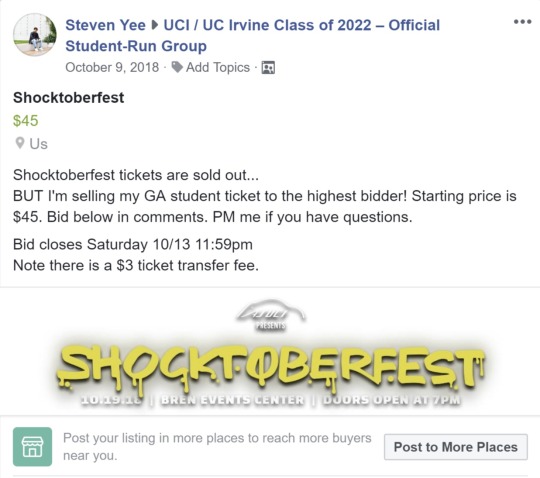
In October of 2018, UCI hosted the annual Shocktoberfest concert at its Bren Events Center. I was not interested in attending the event, however, I recognized that I could turn a profit through resale.
UNDERSTANDING THE MARKET
Tickets to the concert are private goods, meaning they are both excludable and rival in consumption. A student can be excluded from attending the concert, and one’s possession of a ticket detracts from another person’s opportunity to attend because there is a finite number of tickets available.
I also understood that this was a perfectly competitive market. Like me, there were many people who were attempting to resell tickets or at least sell their ticket after deciding they wouldn’t be going after all. There are also many people who wanted to buy tickets to this anticipated concert. This qualifies many buyers and sellers. Ticket owners and ticket sellers also have freedom to enter and exit the market. All tickets are identical because the tickets are for admission, not seats. Therefore, no ticket is of better quality than another. I should specify here that there are General Admission tickets and Floor tickets, as well as student tickets and guest tickets. Therefore, there are actually four different types of tickets for this event. The market for all types of tickets is monopolistically competitive because products are differentiated. I only sold a student GA ticket, and thus I will only be looking at the market for student GA tickets, a perfectly competitive market.
Finally, I recognized that because there are a finite number of tickets available, prices would rise in the market as supply eventually decreased, a result of scarcity. The longer I held onto my ticket, the more valuable it would become in the eyes of the customer. Market supply would decrease as sellers sold their tickets. One of the supply curve shifters is the number of sellers. As you can see in Figure 2, when the number of sellers decreases, the supply curve shifts left. By holding onto my ticket, I allowed the equilibrium price of the student GA ticket to rise and rise. This is also an example of seller expectations about the future. I expected ticket prices to rise, so I reduced my supply to 0 (just didn’t sell), saving inventory to sell high later.

Figure 2. The supply-and-demand graph for the student GA tickets market. Here supply shifts left because there is a decrease in the number of sellers. This raises the price from P1 to P2.
FIRM DECISION-MAKING
How exactly did I know I would be making a profit? And what price was I going to sell my ticket for? What exactly would my profit be?
I knew from the start that I would be guaranteed a profit because my “business” so to speak involved only the one-time fixed cost of purchasing the ticket for myself, and the opportunity cost of me spending time to advertise my ticket sale online and negotiate with buyers. So long as my total revenue was greater than total cost I would make a profit.
I purchased my ticket during the pre-sale period, which was when ASUCI sold tickets at a discount to early-birds. This lowered my cost, which also puts me at an advantage in competition to other sellers. I could sell my ticket at a lower price than other sellers and still make as much profit as if I had sold the ticket at the price my competition was selling at. I can also have a larger producer surplus because my costs are lower.
So here’s the math:
I purchased my ticket at pre-sale for $25. The standard price is $35. Already, I could sell my ticket at standard price after ASUCI sells out of tickets and make a profit of $10 ($35 - $25 = $10).
HOWEVER, as I understood how the market would change. I waited, and in waiting, I had more market power. But wait, how can I have market power or the ability to set price if I am a firm in a perfectly competitive market? The reality is, this market is not perfectly competitive. It is still a competitive market, but it appears more and more like a oligopoly when there are fewer firms and – what is arguably more important – consumers do not have all the information available. I have more market power when I engage in unilateral negotiations with my buyers so that buyers are not aware of what other firms are selling their tickets for or what other buyers are willing to pay for the ticket. I originally used this stragedy.
The other tactic was to put by ticket up for bid. This pitted my buyers to compete with one another. As you can see in Figure 3, I went with this stragedy because a bid accounts for willingness to pay. Buyers would stay competing in the bid for as much as they were willing to pay, and so through this method I could find a buyer with the highest willingness to pay. Additionally, I would only have to make a single post on Facebook instead of negotiating separately with various buyers. This helped to cut back on my time spent, which is an opportunity cost.

Figure 3. I put my ticket up for bidding on the Shocktober Facebook page. Buyers bid in the comments until the closing day. I am able to identify the buyer with the highest willingness to pay and thus I am able to earn the maximum amount of profit based on their demand.
So back to the math…
I purchased the ticket at $25 during pre-sale. I now have a final bidder for $93.01. My final accounting profit is $68.01 ($93.01 - $25). I don’t have an explicit number to describe my opportunity costs that I incurred from this resale process, but I know for sure that my opportunity cost was smaller than the accounting profit of $68.01 because I minimized my work in the process. Thus I know I have positive economic profit.
WELFARE ECONOMICS
The beauty of trade is that both parties benefit from engaging in market transactions. While it may seem that I “ripped-off” customers by having them pay for a ticket far more pricey than its original cost, I actually sold the ticket to someone with a willingness to pay equal to my sale price. This means consumer surplus is 0. My customer paid what he wanted for a good that he desired. I had producer surplus equal to the revenue received minus the costs, which is my economic profit. Total surplus ends up being positive because there was a non-negative consumer surplus and a large positive producer surplus. As Figure 4 from the Mankiw Economics textbook shows, the vast majority of economists agree that the resale of tickets, or “scalping” as it is sometimes called, is a good thing.

Figure 4. 80% of economics agree that laws limiting the resale of tickets makes potential members worse off.

Figure 5. This is a rough sketch of what the WTP graph looks like for my ticket resale. Driven by profit of course, I sold my ticket to the highest bidder determined by the highest willingness to pay.
CONCLUSION
Many of the strategies I employed as a seller I had done so before I took ECON 20A, which I think highlights the prevalence of economics in our daily lives. We often engage in transactions just on the basis of self-interest and incentives like social good and generosity. These incidents could easily be an example straight from our textbook. Reflecting on this prospect, it also becomes clear what Econ Live is intended to do – connect the lessons we have learned throughout this quarter to our own lives. Moreso, I am impressed by the art of the trade and I realize being smart in economics can help me in my own personal and business aspirations.
1 note
·
View note
Photo
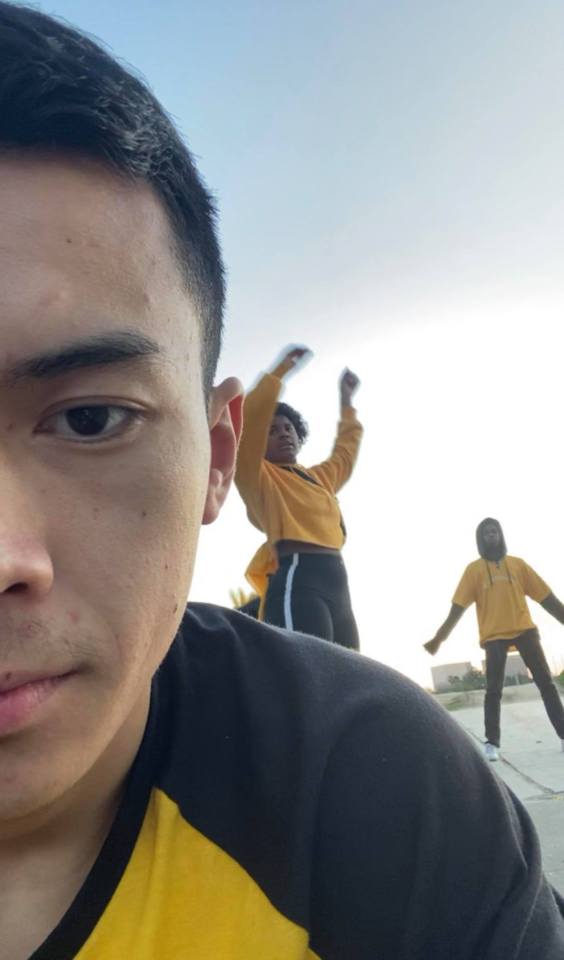


Museum visit, performance, workshop or UCI Illuminations event
Tobee Souvannasing
Professor Greenban
Educ 104e
23 February 2020
Out of the many events at UCI, I’ve had the pleasure of seeing a few and creating my own impression on the culture. The event that I attended incorporated arts and community. On February 19, 2020, UCI’s Associated Student Body (ASUCI) invited my dance team to perform twice during the basketball rally and also the halftime show against Cal State Long Beach. It was my first time performing on the Bren Event Centers basketball floor. It was a big moment for me because the feeling of people on the floor took me back to high school days and made me feel nostalgic.
(Left: Calltime/Tech Rehearsal before show 3pm, Center: Waiting/Supporting our schools basketball team, Right: Selfie during the rally)
I never got to experience an actual game, and I was so excited to know that my team was invited to perform so that we can represent a form of UCI’s Arts. We also saw other dance performances from other UCI’s dance teams like UCI’s official dance team, and Urban Motus. I chose this event because even though it incorporated sports, they also provided fun games during down time, and dance which is my favorite form of art. My team is called MCIA which stands for Modern Completely Insane Anteaters, because we present a modern form of hip-hop dance for entertainment and we’re insane for practicing during long nights till 2-4am. Something that can contribute to what I have been learning in this course is how much community means by bringing individuals from different places together. The presentation and layout of activities is extremely important in order to make each student feel like they belong. They even gave us pizza, a chance to spin a wheel for a free Chick-fil-a item, games, photobooths, and I even got to hear our KUCI’s radio live. The organization of the event was in itself an art, and I’m happy I got to take it in before my days at UCI come to an end. I even got my first UCI Zot foam finger. It made me feel more awake because I got to see how much technology has advanced first hand when they would present the game and activites on the monitor. Media arts plays a huge role in making time pass and making life more exciting. Lastly something I wonder is how I can become advanced in utilizing technology to create something that others can enjoy.
https://teenagecheesecaketraveler.tumblr.com/
0 notes
Photo

"anitya asuci duhkha anatmasu nitya suci sukha atma khyatih avidya" Yoga Sutra II.5 "Confundir lo transitorio con los permanente, lo impuro con lo puro, el dolor con el placer, y lo que no es el sí-mismo con el sí-mismo: todo ello se denomina carencia de conocimiento espiritual, avidya." #ashtanginiavidya https://www.instagram.com/p/ByQNJn7IzHS/?igshid=koz6oj6s0fz4
0 notes
Photo

When you just really connect with the lyrics. Summerlands was pretty hype not gonna lie. First time listening to @p_lo and @ellamai and I was really feelin it, especially with amazing friends. Yay to new music experiences! @madeon though, was perfect for me. Played a lot of his old stuff and a good amount of new stuff and I was def feelin that! #summerlands #uci #ucirvine #irvine #music #festival #asuci #plo #ellamai #madeon #bayarea #simp #edm #shelter #virtualself #island #thecity #fun #adventure #friends (at University of California, Irvine)
#music#virtualself#irvine#uci#island#friends#festival#fun#thecity#ucirvine#edm#ellamai#plo#adventure#simp#asuci#bayarea#madeon#shelter#summerlands
1 note
·
View note
Text
#IAmUCI: Tracy La
Tracy La is a senior majoring in political science and is the current ASUCI president.

Why did you choose UCI?
I chose UCI out of 11 schools that I got accepted into. I visited the campus back when I was in the 9th grade, and immediately fell in love with the campus's physical beauty, the fact that there was a park in the middle of campus, how much simpler it was to get from one side of campus to the other, and I liked the challenge of attending a school that was relatively new and therefore had the opportunity to grow, expand, and challenge itself in its endeavors. Ultimately, I chose UCI because it gave me the opportunity to be far enough from home to be able to live in and explore a new county, while also giving me the opportunity to travel back home whenever I needed to.
What are your favorite things about UCI?
Because of how relatively new it is, students have access to a vast amount of opportunities to challenge and push UCI to continue being an even better place for all students here on campus. Because of this, I've had the opportunity to learn what makes something a best practice, expand my perspectives and skills, and feel important and empowered because of all the things we can do to help UCI grow. I also love Aldrich Park and the ability to relax or nap there in between classes, the cool sustainable features we have, and I love seeing the critically acclaimed "Swag Man" around campus, especially on my rough days because he's become a sign of luck and hope for a better day for me.
What's your advice for new/incoming Anteaters?
Do not be afraid to ask for help or clarity, and don't feel excruciatingly pressured to get involved in everything you can during your first year. I didn't get fully involved or become fully comfortable with being a college student until my second and third year, and this never hindered my ability to get passionately involved with what I cared about and ultimately elected to serve as the ASUCI president. In addition, try to explore all the things you may be interested in and then when you're ready, narrow it down to a few things you want to dedicate your energy to.
Photo courtesy of Tracy La.
**Share your UCI story and photos with #IAmUCI on Instagram, Twitter and Facebook.
3 notes
·
View notes
Photo


2020 Construction in Indian Country, print design, 4″ x 6″ postcard.
0 notes
Text
Monopolist ASUCI Take On UC Irvine
Fame Wutthakul (ID: 27157255)
Kadin Kim (ID: 79238673)
To begin with, we define a monopoly as a firm that is the sole seller of a product without any close substitutes. Some real-life companies that possess this power include Netflix which holds streaming movies and shows online that influence people to stop buying DVDs and televisions altogether; another great example is Google which pretty much started the social media revolution that nobody else could compete. Let’s just say, what would our lives have been without neither one of these monopolistic companies?

In our case, we both are first years who have just entered UCI a few months back, and if it wasn’t for ASUCI, we would never have had opportunities to enjoy “the luxury of being in college.” ASUCI, short for Associated Students of the University of California, Irvine or the one and only student government that has the ability of:
“(...) Providing resources and student programming through student-run events and conferences, overseeing commercial activities such as discount tickets and the quarterly vendor fair, large scale school-wide events such as Welcome Week, Shocktoberfest, and Summerlands, and student services, the ASUCI advocates for students on a university, local, state, and national level and represents the student body on administrative campus and systemwide committees.”
Based on the brief description above, ASUCI is considered to have the monopoly over students and everyone else in UCI because:
They are allowed to exist through the actual government regulation, “has cosignature authorization on contracts for ASUCI, in conjunction with the Executive Director and in accordance with University Policies and Procedures.” The university’s officials and rules are what command ASUCI.
They are given the authority to hold and create all the activities, fairs and events occurring within the university, “develops and maintains programs relating to the civic enrichment of the undergraduate student body and local community, the quality of services offered by UC Irvine administration, and which maintains a level of transparency regarding such services, the academic enrichment for the undergraduate student body, and so on.”
With each event, ASUCI is a price maker, meaning they determine the prices of the tickets and how many they want to supply, “has cosignature authorization with the External Vice President and Internal Vice President over all budgetary expenditures.” They can raise their price for a certain activity, though the demand may decrease but students at UCI would still be willing to purchase their way to attend it since they are the only one who have all the market power.
And because everyone pays ASUCI to participate in the events they host, we can say that they have the monopoly resources that no other organizations or clubs at UCI do. Moreover, there is no competition and an entry for others to come and do the same things.

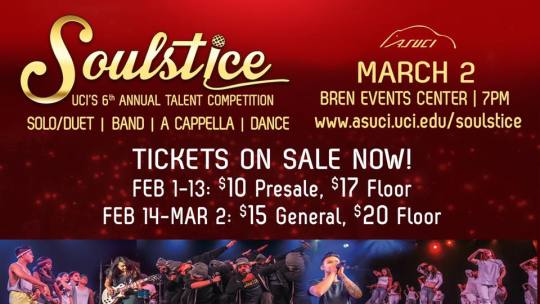

Because ASUCI is the only producer and creator of everything here, their demand curve is sloped downward, looks just like a regular market demand curve. Again, students will still stick with this organization and buy their tickets for the events and whatnot at a raising price, but the quantity demand will be less. However, if they use their monopolist power in a wiser way, they can reduce the amount of tickets they want to sell, the price of the ticket will automatically increase since the demand of students will go up.

This downward-sloping demand curve also affects the marginal revenue as well, this causes ASUCI’s marginal revenue to be less than the price of their goods and services. For example, let’s bring up one of the events they held back in October called “Shocktoberfest.” If ASUCI decided to raise the amount of the ticket supply, 2 outcomes will be produced:
The output effect: more tickets are sold out which will raise the quantity and consequently increase their total revenue.
The price effect: price of the ticket will fall which will decrease their total revenue.
This is why the marginal revenue curve for ASUCI is lower than their demand curve. Worst case scenario, if the price effect is greater than the output effect, their marginal revenue will be negative, meaning the price falls by enough to cause their entire total revenue to decline, despite the fact that they sell more tickets.
Now, we will take a look at how a monopoly like ASUCI maximizes their profits.
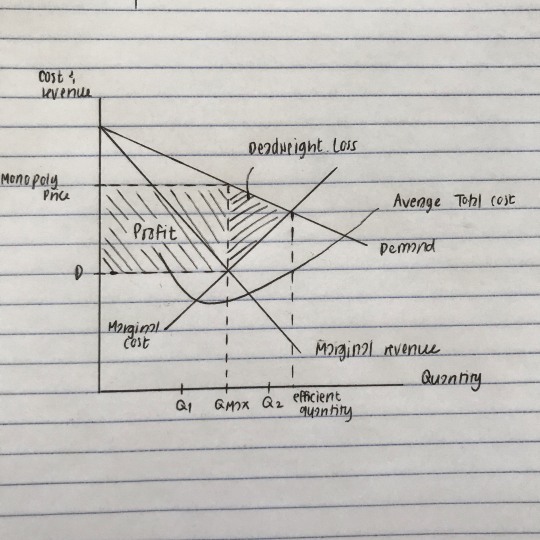
When marginal cost is less than marginal revenue at Q1, ASUCI can still make additional profits by producing more tickets. In contrast, if their marginal cost is greater than marginal revenue at Q2, they need to reduce the amount of tickets if they want to still make profits. All in all, the profit-maximizing quantity of the ticket output is at the intersection of the marginal-revenue curve and the marginal-cost curve at Qmax. The shaded box is the total profit they would make if they were to stick with profit-maximizing point; the height of the box is price minus average total cost, whereas the width of the box is the quantity of tickets sold. However, the price ASUCI charges is above marginal cost, influencing some students who value the tickets to Shocktoberfest at more than they cost to not want to purchase them. The quantity produced and sold by ASUCI may have satisfied their profit goals, but it definitely is below socially efficient level, or the level desired by us students. Therefore, this causes deadweight loss.
Yet, there are several tactics used by monopolistic companies in hopes to achieve higher profits and no losses. One of which that ASUCI has implemented before is called price discrimination, when they sold the same exact tickets of Shocktoberfest to different groups of customer. To make this work, ASUCI members have the ability to separate students according to their willingness to pay.

Again, as we mentioned above, there is a deadweight loss present if ASUCI were to charge every student with the same price. Total surplus would equal the sum of profit which in this case, is producer surplus, and the consumer surplus. But because they had agreed to charge two different prices based on seats and how far they are from the stage, each student who values the ticket at more than marginal cost will purchase it at the price of their willingness to pay. For instance, Sean wants to pay less for the general admission ticket with actual chairs because his legs are sore from the basketball practice, while Erin wants to pay a higher price for a floor ticket because she wants to see the artists closer regardless of chairs. All mutually beneficial trade takes place, there is no deadweight loss and the entire surplus goes to ASUCI in the form of profits.
All in all, it takes practice and experience in the real world for each member of our student government or ASUCI to establish their monopolistic market within the university fences. Although the actual Shocktoberfest concert was a total failure due to ASUCI’s rational decision to shut it down right before the headliner artist appeared, causing a huge chaos amongst students, we must say they have been doing a decent job at providing students like us with events and activities.

0 notes
Text
3. Asubhabhāvanā niddesa
3. Asubhabhāvanā niddesa
1.
Sirimaṃ gaṇikaṃ disvā, dametuṃ rattacetasaṃ;
Dassetvā matasārīraṃ, tassā jino idaṃ bravi.
2.
Caraṃvā yadivā tiṭṭhaṃ, nisinno udavā sayaṃ;
Samañcheti pasāreti, esā kāyassa iñjanā.
3.
Aṭṭhi nhārūhi saṃyutto, taca maṃsāva lepano;
Chaviyā kāyo paṭicchanno, yathābhūtaṃ nadissati.
4.
Antapūro darapūro, yakana peḷassa vatthino;
Hadayassa papphāsassa, vakkassa pihakassaca.
5.
Siṅghānikāya kheḷassa, sedassaca medassaca;
Lohitassa lasikāya, pittassaca vasāyaca.
6.
Athassa navahi sotehi, asuci savati sabbadā;
Akkhimhā akkhigūthako, kaṇṇamhā kaṇṇagūthako.
7.
Siṅghānikāca nāsato, mukhato vamati ekadā;
Pittaṃ semhañca vamati, kāyamhā sedajallikā.
8.
Athassa susiraṃ sīsaṃ,
Matthaluṅgassa pūritaṃ;
Subhato naṃ maññati bālo,
Avijjāya purakkhato.
9.
Yadāca so mato seti,
Uddhumāto vinīlako;
Apaviddho susānasmiṃ,
Anapekkhā honti ñātayo.
10.
Khādanti naṃ suvānāca, siṅgālakāca kimiyo;
Kākā gijjhāca khādanti, yecaññe santi pāṇakā.
11.
Sutvāna buddhavacanaṃ, bhikkhu paññāṇavā idha;
Sokho naṃ parijānāti, yathābhūtañhi passati.
12.
Yathāidaṃ tathāetaṃ, yathāetaṃ tathāidaṃ;
Ajjhattañca bahiddhāca, kāye chandaṃ virājaye.
13.
Chanda rāga viratto so, bhikkhu paññāṇavā idha;
Ajjhagā amataṃ santiṃ, nibbānaṃ pada maccutaṃ.
14.
Dvipādako yaṃ asuci, duggandho parihārati;
Nānākuṇapa paripūro, vissavanto tatotato.
15.
Etādisena kāyena, yo maññe unnametave;
Paraṃvā avajāneyya, kimaññatra adassanāti;
Kāya vicchandanīyasuttaṃ, vijayasuttantipi vattabbaṃ.
16.
Ra-akkharo siyāggimhi, rova aggiva āgato;
Tasmā rāgoti vattabbo, taṇhāva niccatāpikā.
17.
Abhiṇhameva rāgaggi, dayhate subhasaññinaṃ;
Kimikhajjavaṇo sāva, dukkhī rāgī sa sabbadā.
18.
Dukkhī piya maladdhāna, laddhāpya paripuṇṇato;
Natthi rāgaggikhandhassa, piyindhena hi puṇṇatā.
19.
Natthi rāgasamo aggi,
Iti vuttaṃ mahesinā;
Tena rāgagginā daḍḍho,
Sabbo loko tidukkhito.
20.
Ekassa pivitaṃ khīraṃ, catū dadhi jalā bahu;
Rāgahetu bhave sandhi, ṭṭhānaṃ anamataggikaṃ.
21.
Catūdami jalā bhiyyo, sīsacchedana lohitaṃ;
Rāgahetu bhave macca, bhayaṃ anamataggikaṃ.
22.
Ekassa rudato assu, catū dadhi jalā bahu;
Dukkhaṃ anamataggaṃva, taṃhetu paridevanaṃ.
23.
Tattāyo guḷa gilita, vadhaggi dayhanā dikaṃ;
Asaṅkhyeyyaṃ mahādukkhaṃ, taṃhetu niraye labhi.
24.
Eka dvitti catu pañca, buddhuppādepya mocitaṃ;
Khuppipāsita nijjhāmaṃ, labhi taṃhetu pettikaṃ.
25.
Tiracchāne asūreca, dukkhaṃ nānāvidhaṃ labhi;
Namataggika saṃsāre, sabbantaṃ rāgahetukaṃ.
26.
Ekassekena kappena, puggalassaṭṭhi sañcayo;
Sace saṃhārito assa, vepulla pabbatādhiko.
27.
Eka kappe idaṃ dukkhaṃ, nādikappesu kākathā;
Rāgo nanu mahāverī, bālo jano ta micchati.
28.
Rāgasuddhi asokoca, niddukkho ñāyapattica;
Nibbānaṃ pañca paccakkhā, asubhāya phalā matā.
29.
Asubhaggahaṇaṃ jhāyī, mitā sindriya saṃvaro;
Somitya mukkaṭṭhāvācā, chaḷime rāga suddhiyā.
30.
Niccuggarāga rogīnaṃ, asubhā vātulosadhā;
Rāgayakkhābhi gayhānaṃ, asubhā manta muttaraṃ.
31.
Sajīvakāca nijjīvā, asubhā duvidhā matā;
Sajīvā kesalomādi, dasevime ajīvakā.
32.
Uddhumātaka vīnīlaṃ, vipubbakaṃ vichiddakaṃ;
Vikkhāyitaka vikkhittaṃ, hativikkhitta lohitaṃ.
33.
Puḷuva ṭṭhika miccesu, laddhā aññataraṃ sato;
Ratana vānapasseyya, yathā cetasi pākaṭaṃ.
34.
Mataṃ khajjaṃ sa maṃsañca, nilohitaṃ nimaṃsakaṃ;
Vikkhittaṃ seta puñjaṭṭhiṃ, navadhā putimikkhaye.
35.
Maccuto parimuccāmi, paṭivatti yimā yiti;
Payojana samāvajja, moditabbaṃ jigucchake.
36.
Sajīvake jigucchatthaṃ, nijjīvā subha mīritaṃ;
Tathūpamo ayaṃkāyo, evameva bhavissati.
37.
Evaṃdhammo ayaṃkāyo, evaṃbhāvī natikkamo;
Iccupa saṃhare disvā, ekadviha matādikaṃ.
38.
Yathā idaṃ tathāetaṃ, yathāetaṃ tathā idaṃ;
Jegucchaṃ paṭikūlyañca, kāye iccupa saṃhare.
39.
Uddhumāta vinīlādi,
Paṭikūlyo jigucchito;
Tathevāyampi me kāyo,
Viseso nāyu-sāyuva.
40.
Uddhumāta vinīlādo, sobhaṇaṃ natthi kiñcipi;
Imasmiṃpi me kāye, gavesantopi sabbaso.
41.
Paṭikūlavasā dhātu, vasāca dvippakārato;
Paccavekkheyyimaṃ kāyaṃ, icchaṃ virāga mattani.
42.
Vaṇṇa saṇṭhāna gandhehi, āsayo kāsatopica;
Jeguccha paṭikūlyāca, kesā na tuṭṭhamānitā.
43.
Iti kesesu ikkheyya,
Lomā dīsupyayaṃ nayo;
Dvattiṃsevañhi koṭṭhāse,
Paccavekkhe visuṃvisuṃ.
44.
Kāyato bahinikkhantaṃ, paṭikūlyaṃ jigucchitaṃ;
Anikkhantampi jegucchaṃ, paṭikūlyaṃva tassamaṃ.
45.
Saṅkhatampi yathā vaccaṃ, manuññataṃ na pāpuṇe;
Upakkama sahassehi, evaṃ kesādikampica.
46.
Sabhāva paṭikūlyaṃva, ekampi vacca puñjakaṃ;
Nanu jegucchitā bhiyyo, dvattiṃsa vaccapuñjakā.
47.
Paccekampi paṭikūlyaṃ, kesādikaṃ sabhāvato;
Kesādidvattiṃsa puñjo, bhiyyo jegucchito nanu.
48.
Puñjitesveva kantesu, kantohoti sa puñjako;
Puñjitesu akantesa, akantova sa puñjako.
49.
Paccekaṃ vinibhuttesa, kesa loma nakhādisu;
Natthi taññā kumārīvā, mukhahatthādikānivā.
50.
Sampiṇḍi tesu tesveva,
Kuto tā tāni āgatā;
Paññatti matta mevesā,
Jigucchaññā na kācipi.
51.
Santaṃ cinteyya nāsantaṃ, santa cintayato sukhaṃ;
Asantaṃ parikappento, nānādukkhehi tappati.
52.
Nāvajja santajegucchaṃ, saññaṃ asati kātuna;
Subhā itthīti gāraggi, uppajji subhasaññino.
53.
Asantaṃva abhūtaṃva, passe rāgaggijotiyā;
Tāya santañca bhūtañca, na passati kadācipi.
54.
Ekassa pivitaṃ khīraṃ, sīsacchedana lohitaṃ;
Rudato assu taṃhetu, catūdadhi jalā bahu.
55.
Āyatimpi atīteva, saṃsarantassa hessati;
Rāgaṃ hantu manīhoce, khīraṃ assuca lohitaṃ.
56.
Subhasaññāya so vaḍḍho,
Tadabhāve sa nassati;
Thiraṃ hantuṃ na taṃsaññaṃ,
Sakkā sithila vīriyo.
57.
Ussoḷhi vīriyo hutvā, brūheyyāsubha bhāvanaṃ;
Subhasaññāppa hānāya, pariccajjāpi jīvitaṃ.
58.
Aññakicca mupekkhāya, brūheyyāsubha bhāvanaṃ;
Mandi hutveha rāgaggi, nibbāyissati āyatiṃ.
59.
Kiccaṃ me idameveti, brūheyyāsubha bhāvanaṃ;
Dāni mandaggi hutvāna, pāmojjaṃ ve labhissati.
60.
Kāye daṭṭhabba jegucchaṃ, apassanto pamādavā;
Aladdhā kiñci pāmojjaṃ, pabbajjampi na modati.
61.
Pure marāmi kāye smiṃ, passā mi passitabbakaṃ;
Iccā raddho vītiṃladdhā, pabbajjaṃ atimodati.
62.
Kāye daṭṭhabba jegucchaṃ, apassanto pamāda vā;
Moghaṃva dullabhātīto, mahājānīyataṃ gato.
63.
Santaṃ bhūtañca jegucchaṃ, rāgagginā apassiyaṃ;
Paññāpadīpajotena, samikkheyya abhiṇhaso.
64.
Santaṃ bhūtañca kāye smiṃ, daṭṭhukāmo sadāsato;
Paññāpadīpakeneva, dakkhe na rāgīsīkhinā.
65.
Jegucchitena kāyena, nikkhantena jigucchato;
Ajja svevā vinaṭṭhena, nāla munnamituṃ sato.
66.
Kīdisaṃ maṃ tuvaṃ maññi, ahaṃ sabba jegucchako;
Jegucchatoca nikkhanto, icceva vattu marahati.
67.
Kāye jegucchasaññaṃva, kare sabbiriyā pathe;
Tasmiṃ tuṭṭhabbakaṃ natthi, piyāyitaṃ mamāyitaṃ.
68.
Subhāya nava mattānaṃ, asubhā paripācaye;
Santo pakkassa saṃsāro, nanto navassa rāgino.
69.
Kāye asubha saññāya, paripakka sabhāvino;
Ālambesu acāpallā, thirā sambuddha sāsane.
70.
Anto gocarikā pakkā, bahi gocarikā navā;
Pakkā nāsāya uccā te, nīcāyeva navā sino.
71.
Navānavā subhābhogī, nīcānīcā bhigāmino;
Pakkā pakkāva dhījhāyī, santāsantā virāgino.
72.
Sakkā sakkā na dassetuṃ, subhaṃsubhaṃ sataṃsataṃ;
Dhīrādhīrāga mujjhanti, kāye kāye kriyekriye.
73.
Sakkā sakkāpi taṃ kātuṃ, subhaṃsubhaṃ na dhīmayaṃ;
Santosantojigucchaññū, na vānavā subhesako.
74.
Dukāyaṃ suti cintetvā, mamāyantā mahātapā;
Tapaṃ nibbāyituṃ icchaṃ, dukāyaṃ duti cintaye.
75.
Yvāsubhaṃ subhato maññi, konubālotaduttari;
Andho ummattakovā so, nattānaṃ maññate tathā.
76.
Saritabbaka mevetaṃ, kāye jeguccha puñjataṃ;
Mandarāgo manosītaṃ, labheyya tamanussanaṃ.
77.
Gihibhāve apāyeca, rāgayakkhandha ninnitā;
Maṃpi nessati soyakkho, sādemice tadāgataṃ.
78.
Abhiṇha gāhinaṃ rāga, yakkhaṃ ananta dukkha daṃ;
Asubhā tula mantena, vārehi taṃ sa bhāyati.
79.
Rāgayakkho bahumāyo, saddhāmettā divesavā;
Rāgampi kusalaṃ maññi, jano teneva vañcito.
80.
Āturaṃ asuciṃ putiṃ, passa nande samussayaṃ;
Uggharantaṃ paggharantaṃ, bālānaṃ abhipatthitaṃ.
81.
Subhato naṃ maññati bālo, avijjāya purakkhato;
Iccāha bhagavā nindi, bāloti subhasaññinaṃ.
82.
Nhāruṭṭhi taca maṃsāni, saraṃ sataṃ na nindito;
Buddhanindāya mocetuṃ, tānārabbha anussare.
83.
Maññitvā attano bālyaṃ, asubhe subhadassino;
Vāyāmeyya abālāya, kāyaṃ asubhato saraṃ.
84.
Attānaṃ garahitvāna, bālaṃ viparidassinaṃ;
Subhasaññaṃ pahinneyya, kareyyāsubha saññitaṃ.
85.
Visa bhesajjarukkhaṭṭho, ahi ḍaṃseyyasosato;
Yathā tasseva paṇṇādiṃ, khādetvā visa mujjahe.
86.
Evaṃ rāgo samuppajje, kāye gandhādi vāsite;
Anto tasseva jegucchaṃ, cintetvā rāga mujjahe.
87.
Jigucchitena kāyena, apassanto jigucchataṃ;
Unnameti avaññāti, avijjāya purakkhato.
88.
Āyatiṃ maggalābhāya, bījaṃ kareyya bhāvanaṃ;
Bījā bhāve kuto maggo, maggabījā hi bhāvanā.
89.
Maggabījo apāyepi, nimmuggo samaye gate;
Ummujjitvāva buddhānaṃ, maggaṃ labheyya santike.
90.
Ajījassa tu saṃsāro, dīghoyeva anantiko;
Tasmāhi bhāvanābījaṃ, kareyya mocanatthiko.
91.
Abhiṇha pīḷitaṃ rāgaṃ, asubhāya nivāraye;
Mandīhutvā pahīyeyya, rāgo asubha bhīruko.
92.
Mājegucchaṃ mamāyetha, sāva jegucchamāmako;
Ananta dukkha māpādi, jegucchita mamāyanā.
93.
Maṃsalaggo tacacchanno,
Nhārubandho ṭṭhipuñjako;
Moheti chaviyā lokaṃ,
Mahādukkho sa mohito.
94.
Nhāruṭṭhi taca maṃsehi, rāgavaḍḍhaki saṅkhate;
Gehe rogā putī pāpā, vasanti kucchitā sadā.
95.
Luṅgantā vīsa bhūdhātū, pittādī dvādasambuva;
Tāpaṃ jiraṃ dahaṃ pakkaṃ, caturaggi chavāyukā.
96.
Adhoddhaṃ kucchi koṭṭhāsā,
Aṅgacārīca pāṇakā;
Dhātuyoyeva kāyesmiṃ,
Dvitālīsa anaññakā.
97.
Yathā bahi tathā ajjhattaṃ, dhātū bhvāpā nalānilā;
Name nāhaṃ naattāti, saṃmaseyya punappunanti.
4. Mettābhāvanāniddesa
1.
Mettā bhāvana micchampi, suṇa buddhavaco yidaṃ;
Dosa niggahaṇatthāya, doso mettāyaverihi.
2.
Akkocchimaṃ avadhimaṃ, ajinimaṃ ahāsime;
Yeca taṃ upanayhanti, veraṃ tesaṃ nasammati.
3.
Akkocchimaṃ avadhimaṃ, ajinimaṃ ahāsime;
Yecataṃ nupanayhanti, veraṃ tesaṃ upasammati.
4.
Nahiverena verāni, sammantidha kudācana;
Averenaca sammanti, esadhammo sanantano.
5.
Pareca navijānanti, maya mettha yamāmase;
Yeca tattha vijānanti, tato sammanti medhagā.
6.
Kuddho atthaṃ najānāti, kuddho dhammaṃ napassati;
Sadā andhatamaṃ hoti, yaṃkodho sahatenaraṃ.
7.
Ubhinna matthaṃ carati, attanoca parassaca;
Paraṃ saṃkuppitaṃ ñatvā, yo sato upasammati.
8.
Tasseva tena pāpiyyo, yo kuddhaṃ paṭikujjhati;
Kuddhaṃ apaṭikujjhanto, saṅgāmaṃ jeti dujjayaṃ.
9.
Khantī paramaṃ tapo titikkhā,
Nibbānaṃ paramaṃ vadanti buddhā;
Nahi pabbajito parūpaghātī,
Nasamaṇo hoti paraṃ viheṭhayanto.
10.
Akodhena jine kodhaṃ, asādhuṃ sādhunā jine;
Jine kadariyaṃ dānena, saccenā likavādinaṃ.
11.
Yo ve uppatitaṃ kodhaṃ, rathaṃ bhantaṃva vāraye;
Ta mahaṃ sārathī brūmi, rasmiggāho itarojano.
12.
Purisassa hi jātassa, kudhārī jāyate mukhe;
Yāya chindati attānaṃ, bālo dubbhāsitaṃbhaṇaṃ.
13.
Selo yathā ekagghano, vātena nasamīrati;
Evaṃ nindā pasaṃsāsu, nasamiñjanti paṇḍitā.
14.
Samānabhāgaṃ krubbetha, gāme akkuṭṭha vanditaṃ;
Manopadosaṃ rakkheyya, santo anuṇṇato siyā.
15.
Naparo paraṃ nikuppetha, nātimaññetha katthaci nakiñci;
Byārosanā paṭighasaññā, naññamaññassa dukkha miccheyya.
16.
Mātā yathā niyaṃ putta,
Māyusā ekaputta manurakkhe;
Evampi sabba bhūtesu,
Mānasaṃ bhāvaye aparimāṇaṃ.
17.
Sutvāna dusito bahuṃ vācaṃ,
Samaṇānaṃvā puthujanānaṃ;
Pharusena hi na paṭivajjā,
Na hi santo paṭiseniṃ karonti.
18.
Saccaṃ bhaṇe nakujjheyya, dajjā appampi yācito;
Etehi tīhi ṭhānehi, gacche devāna santike.
19.
Na paresaṃ vilomāni, na paresaṃ katākataṃ;
Attanova avekkheyya, katāni akatānica.
20.
Su dasaṃ vajjamaññesaṃ, attano pana duddasaṃ;
Paresañhi so vajjāni, ophunāti yathā bhusaṃ;
Attano pana chādeti, kaliṃva kitavā saṭṭho.
21.
Nidhīnaṃva pavattānaṃ, yaṃ passe vajjadassinaṃ;
Niggayhavādiṃ medhāviṃ, tādisaṃ paṇḍitaṃ bhaje.
22.
Tādisaṃ bhajamānassa,
Seyyohoti napāpiyo;
Iti vuttaṃ munindena,
Tilokaggena satthunā.
23.
Mettā gandhena vāsento,
Dosaṃ dūrekare budho;
Dūrāsannesu sabbesu,
Attano verikesupi.
24.
Hane dosū panāhāni, anattha kārakāni hi;
Tesva santesu sabbesu, mettāhoti sunimmalā.
25.
Sataṃ dujjana vākyehi, namano yāti vikriyaṃ;
Nahitāpayituṃ sakkā, gaṅgānadiṃ tiṇukkayā.
26.
Nahi nindā pasaṃsāhi, sataṃ manovikāratā;
Na kadācipi kampeyya, vātehi selapabbato.
27.
Nadiyaṃ khuddakā nāvā, vicīhi unnatonatā;
Mahānāvā nakampanti, mahantīhi vicīhipi.
28.
Loke pasaṃsa nindāhi, dujjanovunnatonato;
Santopañño nacalati, mahānindā thutīhipi.
29.
Seloselo nileheva,
Vaṇṇāvaṇṇā asassatā;
Lābhālābhā sukhādukkhā,
Yasāyasā nakampati.
30.
Khamādhagga karetassa, dujjano kiṃ karissati;
Atiṇe patito aggi, sayameva pasambhati.
31.
Sayameva sakattānaṃ, maccubbhayena tacchatu;
Māññe tacchatu dosena, kimatthaṃ aññatacchanaṃ.
32.
Māññe taccha tudosena, naseyyo aññatacchanaṃ;
Māñño taṃ ahibyaggheva, domanassena bhāyatu.
33.
Nissāya garukātabbaṃ, bahūnaṃ pāpamocanaṃ;
Acāpallena santena, garukātabbataṃ vaje.
34.
Nissāya garukātabbaṃ, bahūnaṃ puññavaḍḍhanaṃ;
Garukātabbataṃ gacche, dhītiyā sīla guttiyā.
35.
Santaṃ hi sīlavaṃ dhītiṃ, hirottappena bhāyati;
Dujjanaṃ domanassena, ahibyaggheva bhāyati.
36.
Napharusāya vācāya, aññe dameyya paṇḍito;
Attānaṃva dametvāna, aññe saṇhena ovade.
37.
Citte saṇhe asaṇhāpi, navācāpharusā bhave;
Tasmā ovā danādīsu, rakkheyya thaddhacittato.
38.
Attāna movadatthāya, sikkheyya buddhabhāsitaṃ;
Parampi anukampāya, icchanto anusāsaye.
39.
Aññaṃ naniggahe kiñci, sutena paṭipattiyā;
Attaniggahaṇaṃ seyyo, nunnameyya jinoraso.
40.
Nāvīkareyya dosaṃvā, lobhaṃ mānaṃ sakaṃmalaṃ;
Māññe maññantu taṃ disvā, cirappabba jito nuti.
41.
Kakacena ttachedente, verikepinadosaye;
Iccovādaṃ munindassa, sampaṭiccha jinoraso.
42.
Verī accupanāhīpi, rūpeva dukkhakārako;
Na tva tabbisaye nāme, dukkhaṃ mākari cetasi.
43.
Verī tibandha veropi, iheva dukkhakārako;
Bhavantaraṃ naanveti, sakammunā gato hiso.
44.
Dosotu iha pīḷetvā,
Dukkhāvaho bhavebhave;
Mahānattha karaṃ dosaṃ,
Kasmā vaḍḍheti cetasi.
45.
Mettāsītambusekena, jinovāda manussaraṃ;
Mahā nattha karaṃ dosaṃ, nibbāyatu sa cetasi.
46.
Chaddanto luddakaṃ pāpaṃ, bhūridattohi tuṇḍikaṃ;
Dhammapālo khami tātaṃ, kapindo kandaro pataṃ.
47.
Asaṅkhyeyya ttabhāvesu, paravajjaṃ titikkhato;
Nāthassa pāramiṃ khantiṃ, saraṃ dhīro titikkhatu.
48.
Sāsane ciravāsena, evaṃ niddosakā iti;
Tuvaṃ paṭicca maññantu, sāsane sappayojanaṃ.
49.
Sāsane cira vāsāpi, mādisāva ime iti;
Tamāgamma namaññantu, sāsane nippayojanaṃ.
50.
Dve usetīti doso so, saparaṃ dayhate dvayaṃ;
Pahātabbo sa sabbesu, parattha sattha micchatā.
51.
Paradinnehi noāyu, tiṭṭhate nāttano vasā;
Paravajjaṃ khametabbaṃ, nasādhu aññavirodhito.
52.
Jeguccha kkosa nindāni, bālo gaṇhāti akkhamo;
Khamantotu nagaṇhāti, jānaṃ jegucchitāniti.
53.
Paradinnāni vaccāni, pābhatanti nakocipi;
Gaṇheyyevaṃ duruttāni, agaṇhanto khame sato.
54.
Nadi kallola viciyo, tīraṃ patvā samantidha;
Sabbe uppatitā dosā, khantipatvā samanti te.
55.
Dosummattaka vācāya, nummatto kiṃkarissati;
Bhave yyummattako sova, tādisaṃ vacanaṃ bhaṇaṃ.
56.
Kodhano akkhamo añña, duṭṭhasaññī bhayāluko;
Gāmamajjhe aḷakkova, tathā māhohi taṃ jaha.
57.
Mettāluko khamāsīlo,
Sabbaṭṭhānesunibbhayo;
Parattha sattha micchanto,
Khanti mettañca bhāvaye.
58.
Parakkosāni nindāni, taṃva paccenti nāññagū;
Khittaṃpaṃsuva vātuddhaṃ, garukaṃ kiṃ khamāyate.
59.
Akkosantoca nindīca, pīḷito saka kammunā;
Idha peccaca nīceyyo, naṃnayaṃ gaṇhi akkhamo.
60.
Akkoso maṃ naāgacchi,
Tassevā natthakārako;
Iti ñatvāva sappañño,
Akkosaṃ na garuṃ kare.
61.
Vikārāpatti micchanto, verī bahu mupakkami;
Māmittavasa manvehi, nibbikāro tuvaṃbhava.
62.
Mettambunā saddosoca, paradosoca sammati;
Mettāsekena sabbesu, sabbatoggiṃ nipāraye.
63.
Sadosa paradosaggiṃ, sabbato disato ṭṭhitaṃ;
Mettā toyena vāreyya, siyā nibbuti sabbadhi.
64.
Nagame attano aggiṃ, paraggiṃvāpi nāgame;
Mettambunāva nibbātu, saparaggi dvayaṃ bhusaṃ.
65.
Guṇī guṇī nandindāya, pasaṃsāya guṇī guṇī;
Nindaṃnindaṃ nakuppeyya, nasādiye thutiṃ thutiṃ.
66.
Guṇaṃ nindāya nāsetuṃ, nasakkā koci kussako;
Vaḍḍhetuṃvā pasaṃsāya, garuṃkare na taṃdvayaṃ.
67.
Dosabbhā mala sañchanno, mettācando na rocati;
Taṃmuttassa tu etassa, atissaya pabhāvato.
68.
Su sutta buddha supinā, dvepiyā gutti nākkamo;
Samādhi sumukhā muḷhā, brahmā tyekā dasa gguṇā.
69.
Sītaṃ karotu mettāya, cakkhuṃ lābhetu paññāya;
Mākāsinippabhe caññe, cando hohi gategate.
70.
Dūrāsannesu sabbesu, mettaṃ pesetu pābhataṃ;
Dhammaṃ desetu pattānaṃ, cando hohi gategate.
71.
Sampattānaṃ malaṃ dhova, sītaṃkare sadādayo;
Uccanīce navisese, jalassamo gategate.
72.
Asaassatesu phuṭṭhesu, lokadhammesu aṭṭhasu;
Patiṭṭho nibbikāro tvaṃ, pathavīsadiso bhava.
73.
Nākāsi kalahaṃ silā, sadā kenaci niccalā;
Mettāyanto khamāyanto, mahāsilaṃ guruṃkare.
74.
Silāva sīlavā hotu, duruttāni titikkhatu;
Paccutte dosasaṃvaḍḍho, anuttova pasambhati.
75.
Sabbe ahaṃva icchanti, sattā sukhanti ñātuna;
Bhāveyya kamato mettaṃ, piya majjhatta verike.
76.
Sabbe tasanti daṇḍassa, sabbe bhāyanti maccuno;
Attānaṃ upamaṃ katvā, nahaneyya naghātaye.
77.
Sukha kāmāni bhūtāni,
Yodaṇḍena vihiṃsati;
Attano sukha mesāno,
Pecca so nalabhesukhaṃ.
78.
Averā byāpajjā nīgho, sukhī cassaṃ ahaṃva me;
Hitakāmā tathā assu, majjhattā verinopica.
79.
Mātaro bhātaro ñātī, dāyako pāsakāpica;
Sukhīhontūti bhāveyya, caje tesuca lagganaṃ.
80.
Doso mettāya dūrāri, taṇhā āsanna verikā;
Taṇhaṃ piyesu vāreyya, dosaṃ verīsu mettiko.
81.
Ekuddese kakammāca, sissā ācariyā sukhī;
Hontu sabrahmacārīca, teca ññoñña hitāvahā.
82.
Rājānoca amaccāca, gāme issariyā sukhī;
Bhavantu devatāyoca, tehi surakkhito sukho.
83.
Mayaṃ yena suguttāva,
Sukhitā raṭṭhavāsino;
Sukhī kalla tthu sorājā,
Tejavanto cirāyuko.
84.
Raṭṭha piṇḍena jīvāma, raṭṭhavāsī sukhantuti;
Bhāveyyevaṃ amoghaṃva, raṭṭhapiṇḍaṃ subhuñjati.
85.
Āpāyikā bahū santi, mātāpitādi pubbakā;
Tecaññeca sukhīnīghā, ssva byāpajjā averino.
86.
Sattā bhūtāca pāṇāca, puggalā attabhāvikā;
Thī pū riyā nariyāca, devānarā nipātikā.
87.
Averā hontu byāpajjā, anīghāca sukhī ime;
Attānaṃ parihārantu, catudhā iti bhāvaye.
88.
Puratthimāya disāya, sabbesattā averino;
Abyāpajjā sukhīnīghā, hontūti tāva bhāvaye.
89.
Puratthimāya disāya, sabbepāṇātiādinā;
Dvādasakkhattuṃ bhāveyya, sesāsupi ayaṃnayo.
90.
Catuddisā nudisā dho, uddhaṃ sattāca pāṇino;
Bhūtāca puggalā atta, bhāvī sabbe thi pūrisā.
91.
Ariyā ariyā devā, narāca vinipātikā;
Averā byāpajjā nīghā, sukhattāca bhavantu te.
92.
Catuddisā nudisā dho, uddhanti dasakedisi;
Dvādase te paricchijja, bhāveyya puggale budho.
93.
Mettā vassena temetu, pajjuntoviya sabbadhi;
Mākiñci parivajjehi, evaṃ mettā subhāvitā.
94.
Pañcā nodhi sattodhisā, siyuṃ dvādasapuggalā;
Ntu catūhesu bhāvetvā, aṭṭhatālīsakā siyuṃ.
95.
Dasakedisi tāmettā, catussata asītiyo;
Aṭṭhatālīsāhi pañca, satā ṭṭhavīsa sādhikā.
96.
Dukkhite karuṇaṃ brūhe, muditaṃ sukhite jane;
Mettāceva upekkhāca, ubho ubhosu bhāvitā.
97.
Brahmavāsīti vattabbo, tesvaññatara vāsito;
Gandhabhūtesu so loke, brahmāviya virocati.
source https://theravada.vn/3-asubhabhavana-niddesa/ from Theravada https://theravadavn.blogspot.com/2020/08/3-asubhabhavana-niddesa.html
0 notes
Quote
No text found
https://www.reddit.com/r/quotes/comments/asucis/education_is_the_most_powerful_weapon_which_you/?utm_source=ifttt
0 notes
Text
From Uninvolved to Social Justice Leader
Zoe Broussard is an Arlington, Virginia native entering her 3rd year at UC Irvine. She is majoring in African American studies and minoring in Philosophy. She was a bit involved in high school as she remembers being editor in chief at her high school’s newspaper and performing at countless concerts in her school’s orchestra as a cello player. Although she participated in these after school activities, she was rarely involved in social justice movements. She recalls how she has changed since moving to California as she anticipates another year across the country from home.
“I didn’t really pay attention to race issues during high school, I knew racism was still a thing but I was just one person and I didn’t really believe I could make a difference.” says Zoe. Towards the end of her senior year in high school the country saw an uproar of social justice movements in response to the mass police killings of unarmed black folks. Zoe was especially close to the heart of these movements as she lived half an hour from Washington D.C. But she did not find herself at these rallies, instead she felt as if she did not belong in these spaces and would rather remain silent and move along with her life.
A cold January night would change Zoe’s attitude towards social justice movements forever. She remembers an incident where she decided she could not be complicit anymore. She was walking home through her routine path when she noticed an elderly black man being harassed by a couple of cops for no apparent reason. As much as Zoe wanted to be home after a long day she attempted to assist the old man and defend him against these cops. Unfortunately, she found herself unable to help, the cops asked Zoe to leave or else she would be arrested. As she continued down the dark streets of Arlington she realized that incidents like these occur every day and she could not be silent about it anymore.
Zoe remembers arriving to her house after the event and explaining to her mom what happened in distraught detail. “Maybe you should start going to those rallies, there is always one on the news and I’m sure you can find information about the next one”, Zoe’s mom tells her to make her believe she does have some type of voice in these issues. From this moment on Zoe spent her summer before entering college learning about different movements and knew she would want to pursue social justice when she ventured off to California.
As she entered her first year at the UC Irvine she knew immediately she wanted to place herself in a position where she could make direct change. She had some issues in mind she wanted to help such as combating police violence, battling the rise of tuition, and fighting the high rates of incarceration of minorities. She was accepted as an organizing intern under the Associated Students of the University of California Irvine (ASUCI) during her 1st year. “I did not know there were so many steps and tactics when it came to organizing”, says Zoe as she explains her first time in a workshop.
Some of the responsibilities she had as intern were publicizing events, making signs/posters for protests, late nights of planning protest details, presenting educational workshops, attending organizing conferences, and regularly debating with administration over student resources. She describes her weeks as hectic since she was a full-time student, working as a bus driver, and spending up to 14 hours as an intern. As an intern, she became very aware of the violence students faced on campus. To those interning with her she came off as a leader and someone who put others before herself.
She surprised herself when she applied to be a commissioner for her 2nd year but the real shock she says was when she received the position. “I guess I wanted to still be involved and being a commissioner was the next step so I just applied, interviewed, and luckily received it”, says Zoe. From here on out many responsibilities fell on her lap, many times without her knowledge. She was made the head of the planning committee for the 2016 Students of Color Conference (SOCC) which would be held at UC Irvine under the 2016 External Vice President (EVP) without much input from Zoe. This was one of the biggest student led and run conferences in the UC system.
The conference came but it brought its challenges. Zoe faced a big obstacle when many students disagreed on the theme of the conference which was about antiblackness across communities who were not black. She and the rest of the planning committee held an open discussion where the topic could be dissected and understood. Zoe took on the role of explaining different terms to teach students and having discussions. Unfortunately, no matter the effort, many took the theme of antiblackness as an attempt to minimize their issues. Zoe describes the event by saying, “The conference wasn’t what we expected which sucked. I still have nightmares about how hostile it got but it just taught us what we had to do different next time”. As the conference ended she knew many things had to change especially the way we conduct discussions and the lack of education many students have when entering a conference of this magnitude.
Towards the end of her 2nd year many approached her to run for EVP in the ASUCI elections for the following school year. Zoe proved to be a perfect fit over the past couple years and her exceptional ways of handling difficult situations was remarkable. Zoe debated this as the position requires almost 30 hours a week and required her to oversee multiple commissions and be in contact with multiple student organizations and even administration. She surprised herself once more as she submitted her application to run as a candidate, Zoe was no longer that silent girl from Virginia but rather a fighter for justice.
Zoe’s main platform during the election was to emphasize grassroots organizing which puts the community who is facing the oppression above everyone else while organizing. Zoe ran unopposed throughout the election securing her victory. She received 4,000 votes which was 2,000 more votes than what the ASUCI president received. Despite this victory, the difficulty of school had taken its toll on Zoe and she debated whether to take a break from organizing. To this day, she is still working as a bus driver and she claims, “Having a job, position, and dealing with school has not been easy but I have to work.”
On April 26, 2017 Zoe was officially announced as the new EVP for the following school year. She has been shadowing the current EVP to be prepared for the transition. Zoe describes her main focuses for next year as coalition building and fighting for campaigns such as making the UC a sanctuary university, tuition roll back, and increasing mental health resources for students. Zoe wants to bring mental health resources to organizers and activist in low income cities after she graduates.
by Joshua Erazo
0 notes
Text
Benched at UCI: 6 Facts About the Aldrich Park Benches
By Iris Ruvalcaba
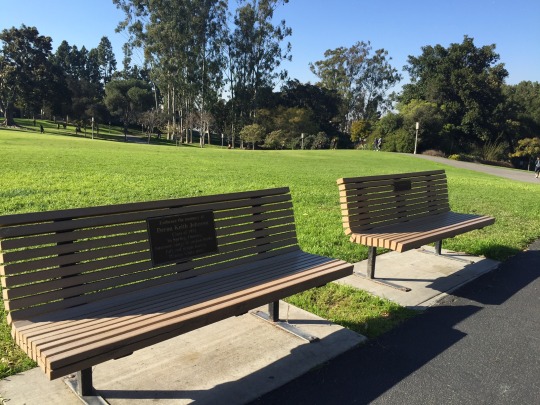
Photo by Iris Ruvalcaba
It costs a mere $5,000 to get a plaque of your choice on a bench in the heart of the UCI campus.
And this fact is just one of many in the little-known story of the 15 benches sprinkled across Aldrich Park, the 19-acre botanical garden contained by Ring Road.
1. They’re Not Just for the Lifeless
If you’ve ever taken the time to read some of the plaques on the benches, you’d notice that while some are dedicated to people who have passed away, others are actually honoring people who are in fact, still alive.
Some honoraria plaques honor people such as professors or staff members who had some type of influence or served some time at UCI. Memorial plaques usually memorialize people such as Michael Robert Belko, who served as an ASUCI at-large Representative; John Rosendahl, who “made physics an adventure for students of all ages”’ and Syed Kabeer Bahadur, who was lauded on the plaque as the “Dopest Fool” the buyer of the plaque had ever seen.
2. The Process Is Not Too Difficult (Not Cheap Either)
Acquiring plaques on a bench requires time more than anything else. Nancy Locke, Donor Relations Office Manager, who is the person in charge of this bench program said the first step in acquiring one of these benches involves filling out a pledge form and giving $5,000 to make it happen.
Locke said this cost has been the same for quite some time but could increase in the future. Once the money is all set, the buyer(s) along with Locke and the UCI Planning Committee will walk along Aldrich park to determine what locations are available to place a bench. Location availability all depends on safety requirements and could require altering environmental elements as a precaution. Once a safe location is determined, the plaque and bench are made to order and are soon installed.
3. Specially Designed for Your Back
These benches are not only custom made to order with varying messages on the plaques, they are also specially designed by an orthopedic doctor. That’s right! This program actually invests in making sure the benches are helping your posture!
The benches in the park are also special because they’re made of plastic, whereas those in other parts of UCI are made from wood. This is purposely done to minimize the maintenance required from possible weathering issues.
4. Different Plaque Sizes Explained
If you have a keen eye for detail, you may have noticed most of the plaques vary in size. This is because the program used to give buyers free range as to how big they wanted it. That was until too many metal clamps were needed on the back of the benches to carry the weight of the plaques, which wasn’t aesthetically pleasing at all.
Around 2003, the Architecture Committee at UCI came together and decided it was time to create a standard plaque size (4x6 in). This means the older plaques are the bigger ones and the newer ones are uniform and smaller in size although some can still be widened to fit all the wording.
5. How Many Are There?
UCI has 50 plaque-bearing benches, with Aldrich Park housing 15 of those benches. The other 35 are scattered all around the university. If you want to keep track of them all, you can just look out for a number labeled on one of the benches legs!
6. Bench Facing China
The weirdest request made pertaining to a bench was that the bench had to face China, according to Nancy Locke. She said mapping it out made it difficult but that she was thankful China is a large country as otherwise it would have been harder to accommodate.
The request was made so long ago that Locke would have to search many files to pinpoint the bench. Can you figure out which bench faces China?
Bonus Fact: Nesting Aldrich
On top of the 15 plaques within the large botanical garden that we call Aldrich Park, there is an additional plaque located in the center of it all.
This plaque is dedicated to the founding chancellor himself, Daniel G. Aldrich, and is mounted within a smaller garden called the Aldrich Rock Garden. That’s right! UCI is essentially a nest of gardens around Aldrich himself.
0 notes